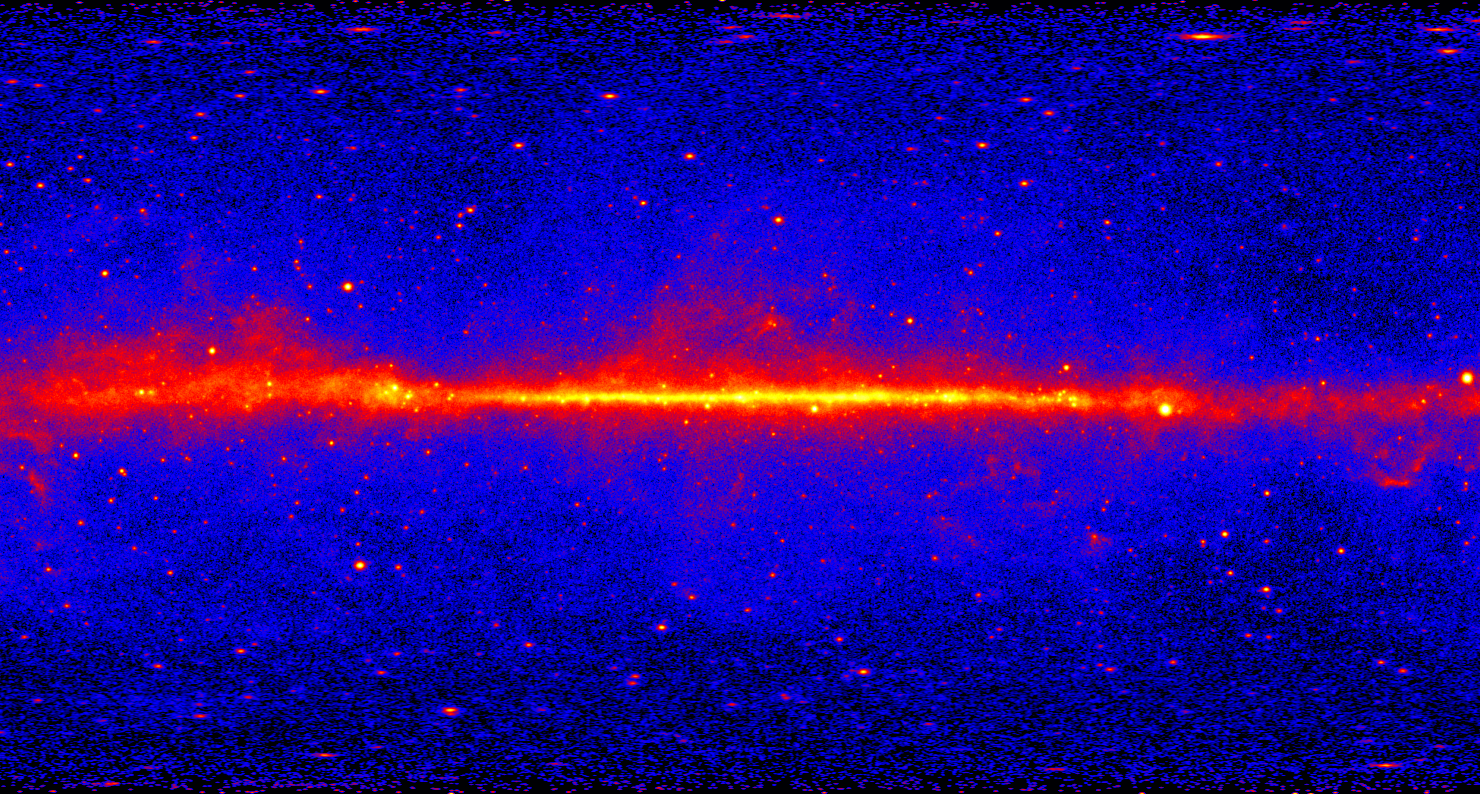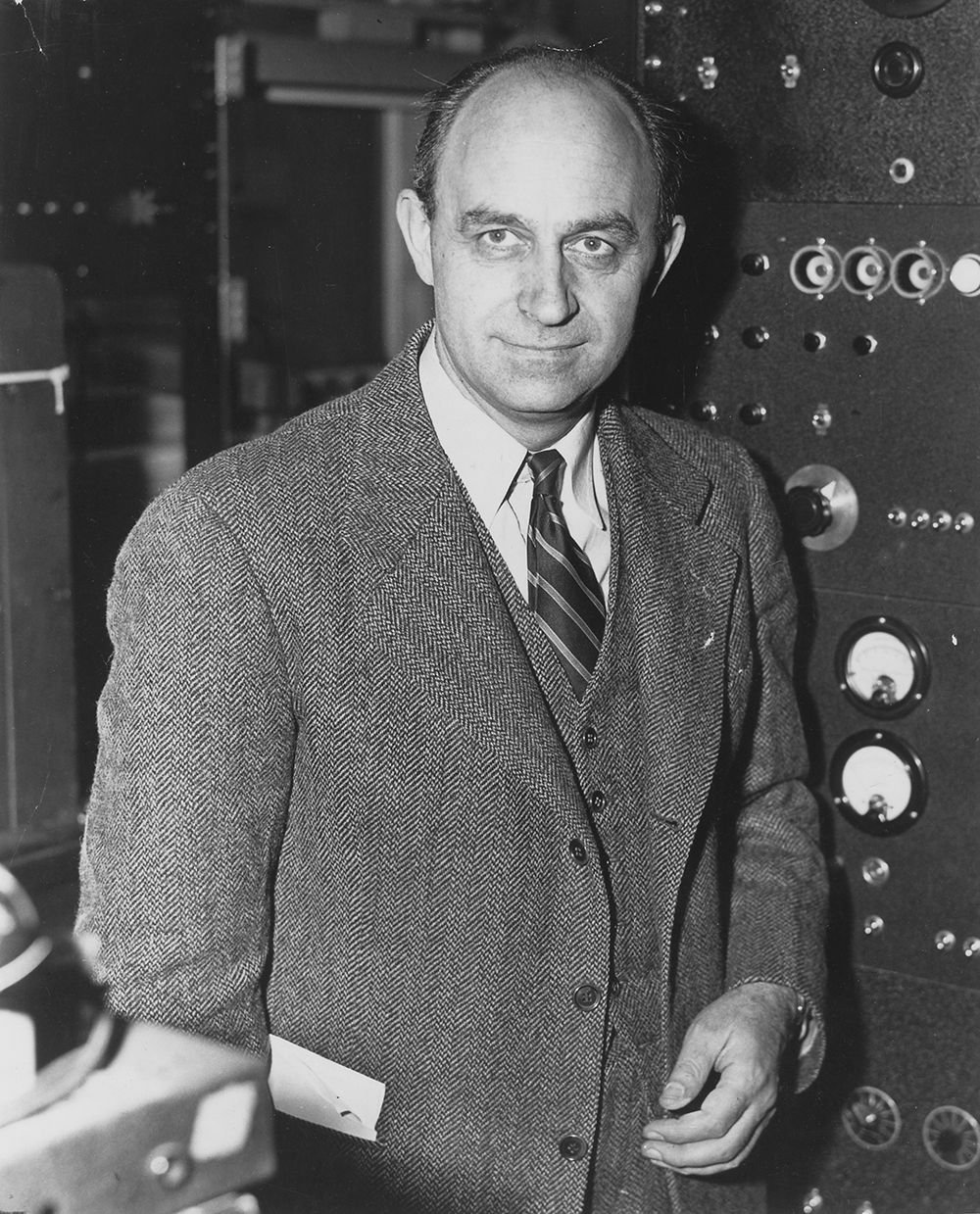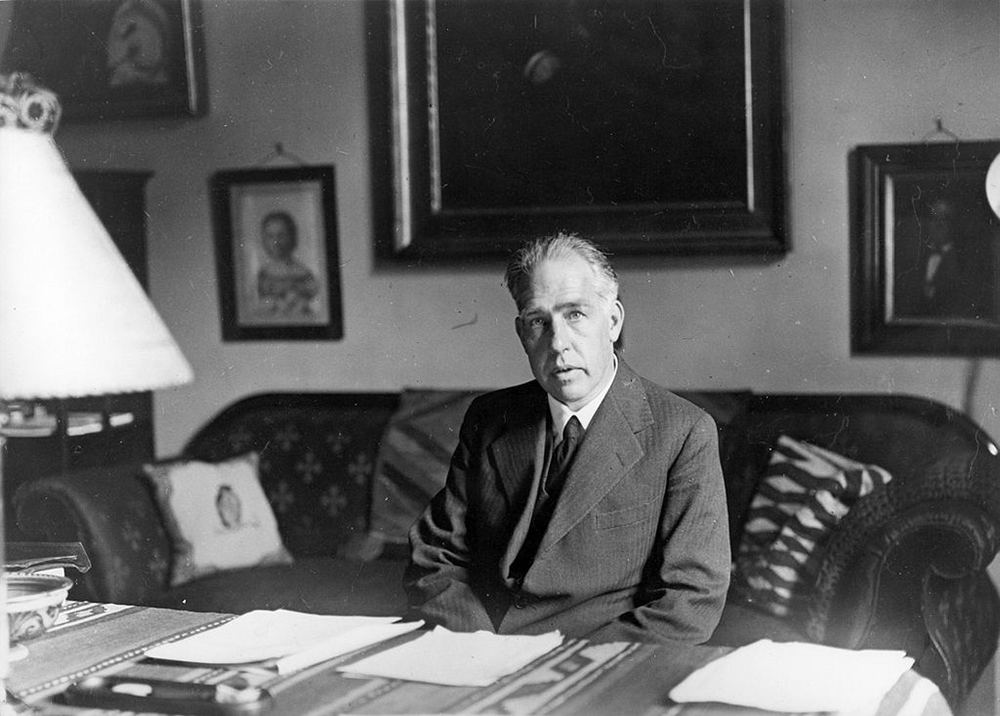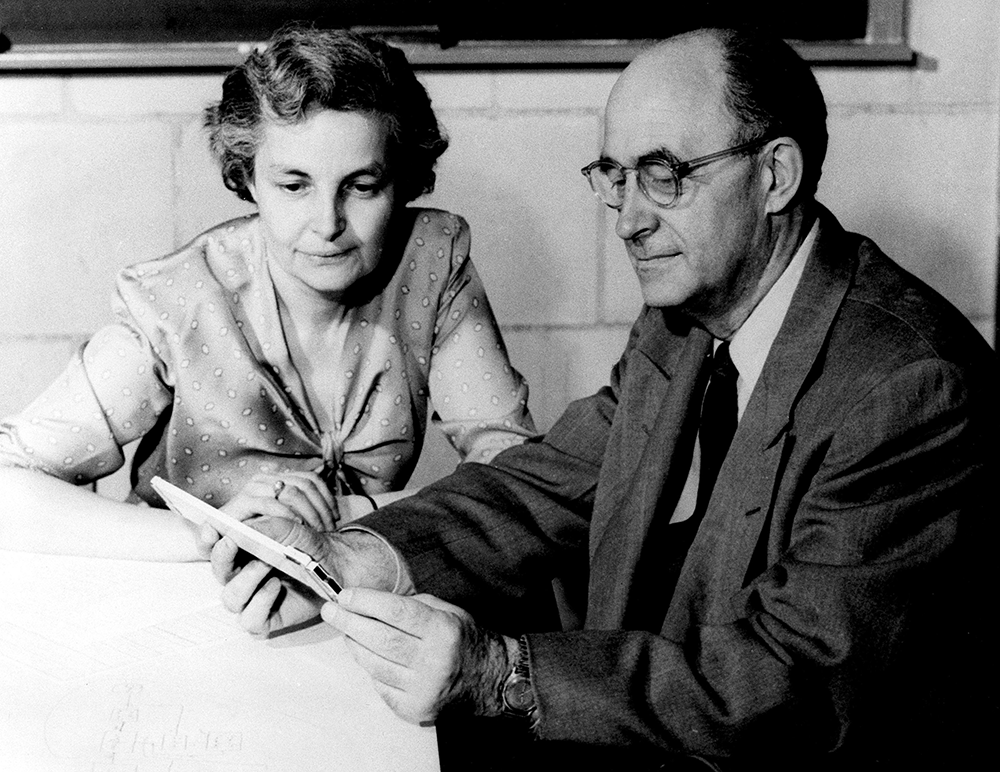
The Fermi Large Area Telescope’s five-year view of the gamma-ray sky, 2013. The bright band in the center marks the central plane of the Milky Way galaxy. Launched in June 11, 2008, the telescope was first called the Gamma-ray Large Area Space Telescope; NASA renamed the mission that August in honor of Enrico Fermi. NASA/DOE/Fermi LAT Collaboration.
In October 1938, Enrico Fermi was in Copenhagen for a conference hosted by Niels Bohr. At one point during the conference, Bohr asked Fermi whether they might have a private word. Pulling him aside, Bohr asked Fermi an astonishing question: If Fermi were to be awarded a Nobel Prize, would he be in a position to accept?
The story of Fermi’s Nobel Prize is one of the more fascinating tales of intrigue surrounding the world’s most prestigious scientific award. It begins, however, not in October 1938 but in 1936 and involves not the physics prize but the more controversial peace prize. In 1936 the peace prize was awarded retroactively to a German peace activist named Carl von Ossietzky, who in 1935 revealed the secret of German rearmament to a stunned world. For this act the Nazi government charged him with high treason and sent him to a concentration camp, where he ultimately died. In the meantime, to garner support for his release, the Nobel Peace Prize committee awarded him the 1936 prize. Predictably, Hitler flew into a rage and decreed that no German national would ever again be allowed to receive the Nobel Prize in any field. The whole episode was a public relations catastrophe, one the Nobel Foundation was determined not to repeat.
The Nobel Foundation delegates the task of naming the winners in physics and chemistry to the Royal Swedish Academy of Sciences, a small committee that decides in strict secrecy on the basis of recommendations from a select group who are canvassed confidentially for their views. Only recently have files been opened to scholars interested in the nomination process and even then only in instances when the winners have passed away. Anyone can submit a Nobel Prize nomination—nominators need not have won to be invited to submit names. For example, Fermi nominated Werner Heisenberg several times before Heisenberg won the prize in 1932, prior to Fermi’s award. Paul Dirac and Erwin Schrödinger shared the prize the following year. Records show the surprising fact that Dirac had received only three nominations prior to the award, whereas Schrödinger had received forty-one, including two from Einstein and three from Bohr. The award is not, and never has been, simply a popularity contest. The great German theoretician Arnold Sommerfeld was nominated over eighty times but never won.

None of this, of course, would have been known to Fermi at the time. He is the first and, as far as records go, only person to have been approached beforehand to see whether he would be able to accept the award.
The concern of the Swedish Academy was that, with Italy growing ever closer to Germany, Mussolini might feel compelled to follow Hitler’s lead and prevent Fermi from attending the ceremony and accepting the prize. However, they need not have worried. Fermi may not have known Mussolini well at all—he met him once and, like many Italians, came away more impressed than he had anticipated—but he knew enough about the fascist regime’s need for international acceptance that he could say with confidence that it would not be a problem. Bohr dutifully reported back to the academy.
Fermi received thirty-six nominations over the course of his career, of which three were in chemistry and the rest in physics. Heisenberg nominated Fermi in 1936 and 1937. The de Broglie brothers, Louis and Maurice, nominated Fermi repeatedly. His old friend Enrico Persico, though never a laureate himself, was actually the first to nominate him. James Franck from Germany and Arthur Compton from the University of Chicago also nominated him. Max Planck was another supporter. Absent from the list, ironically, given the sequence of events, was Bohr himself. In 1938 Bohr nominated no one. In previous years, he nominated Schrödinger and Heisenberg as well as Franck and Otto Stern. Bohr had enormous respect for Fermi, but perhaps he limited his nominations to those with whom he had worked directly. For all their interactions at conferences and meetings and the visits Fermi made to Copenhagen, the two never actually worked together. In addition, they had very different approaches to physics: Fermi utterly disinterested in anything other than physics itself, Bohr almost mystically fascinated by what physics revealed about the nature of underlying reality.

In any case, Bohr’s question posed a dilemma for Fermi. The prize came with a twenty-three-karat gold medal weighing a bit more than six ounces and a significant cash award, some 155,000 Swedish kroner in 1938, worth more than $500,000 in today’s money. Italy had imposed currency restrictions that would prevent Fermi from taking the money with him if he brought it back to Rome and then left when he had originally planned, in the first quarter of 1939. Upon his return to Rome from Copenhagen, he discussed this with Laura, his wife, and they quickly changed their plans. They would take with them to Stockholm as many of their belongings as they could discreetly manage, receive the prize, and go directly to their new home in New York, bringing the medal and prize money with them.
So when the call came from Sweden to the Fermi household, on November 10, 1938, it was not entirely a surprise. As Laura describes the events of the day, an initial call came through from an international operator early that morning before Enrico left for work informing them that they would be receiving a call from Stockholm at six o’clock that evening. Laura took the call and then woke Enrico; they realized immediately what the afternoon call would be about. When Laura proposed that Enrico should skip work and spend the day with her to celebrate, he demurred. He understood that it was quite likely that the call would deliver the news he had anticipated after his conversation with Bohr in Copenhagen, but as someone who always calculated the odds, he also understood that he might be sharing the prize with another scientist. Dirac shared it with Schrödinger in 1933 and the prize was split again in 1936 and 1937. Fermi was not willing to go on a spending spree to celebrate without further information, and he also worried that buying too many transportable objects of value might give away their plans to leave permanently. In the end, Laura persuaded him to join her on a shopping trip, but he limited himself to purchasing a watch—“inconspicuous and useful,” as he described it.
Laura spent the day with her husband, absorbing the sights and sounds of the Rome she loved, the Rome that had been her home since birth. As she later described:
I was determined to be of good cheer and to chase away the nostalgia that came over me at the familiar sight of the Roman streets; of the old, faded buildings that had preserved their full charm; of the clumps of ancient trees that everywhere disrupted the monotony of the streets, rising above a discolored wall or behind an iron fence, silent and monumental witnesses to human restlessness; of the numberless fountains of Rome, which indulged the opulence of water, shot it toward the sky, and let it come back in cascades of diamond-like droplets, in rainbow patterns. I was going to enjoy these sights and give thanks to God for thirty years of life in Rome.
It would be hard to find a more wistful, elegiac tribute to Rome, what it meant to her, what she would lose by leaving it behind.
Later that afternoon, they sat by the phone anxiously awaiting the call. Six o’clock came and went without the call they were expecting. Enrico turned on the radio to provide a distraction, only to find the airwaves filled with news of yet another wave of anti-Semitic laws promulgated by the increasingly desperate regime, laws with real bite: prohibiting Jews from attending public schools, firing Jewish teachers, restricting the practices of Jewish professionals to Jewish clients only, withdrawing passports, and even dissolving firms and commercial enterprises owned by Jews. By the time the call came, the Fermis were in need of some good news. They got it.
Fermi had been awarded the Nobel Prize in Physics on his own. He would share the prize money with no one. The award would cite Fermi “for his demonstrations of the existence of new radioactive elements produced by neutron irradiation, and for his related discovery of nuclear reactions brought about by slow neutrons.”
The original plan did not include a stopover in Stockholm. The new plan did, and unfortunately that meant traveling by train through Germany. Although there was no other sensible way to get to Stockholm, a trip through Germany posed a problem. Enrico and the children would carry passports that indicated they were Roman Catholic, but Laura’s would identify her as a Jew—that is, if Italian authorities decided not to revoke her passport as part of the new racial laws. A passport with a stamp indicating Laura was a Jew could cause serious problems at the German border. As a practical step, the solution was clear. Laura had to convert. In the modest San Roberto Bellarmino church on Via dei Parioli, the Monsignor Ernesto Ruffini—who was later elevated to cardinal and who became an ardent opponent of church reform in the early 1960s—baptized Laura into the Catholic faith and conducted a quiet religious marriage between Laura and Enrico to seal the deal. Laura never mentioned her baptism or second marriage ceremony in her memoir, suggesting a certain discomfort with this aspect of their departure. Yet one can understand her actions, even though, like her husband, religion played no part in her life. This act of apparent hypocrisy enabled her passport to read the same as her husband’s and her children’s. There would, presumably, be no problems at the border with Germany.

The final preparations were fraught. How much to bring with them was an issue—they told Italian officials that they were taking a six-month sabbatical, so bringing the entire contents of the apartment at Via Magalotti was out of the question. In fact, bringing any furnishings at all would have tipped off the government to their real plans. In the end they decided to bring a minimum of clothing and only one of their household help. Laura would shoulder most of the burden of child care herself, at least until they had settled sufficiently and could make new arrangements in New York.
Their train departed from Rome’s Termini station on December 6, 1938. The greatest Italian scientist since Galileo was on his way into self-imposed exile. He would return only twice after the war, never for more than a few weeks.
The train ride was stressful, particularly when a German border official had trouble finding the transit visas that Enrico had obtained for the whole family, but the confusion was settled quickly and the family passed through Germany without any further problems. In Stockholm they were put up at the Grand Hotel, which richly merits its name, and were received by the Italian ambassador, a sophisticated man from an aristocratic family. Laura liked him.
The ceremony, on Saturday, December 10, 1938, followed roughly the same format as all Nobel ceremonies before or since. It started at the Royal Opera House, where Enrico Fermi and Pearl S. Buck, the American author and only other recipient that year, sat on stage waiting to be introduced to King Gustav V. We know from Laura that Enrico was obsessing about his evening wear. He may have been familiar with the elaborately ridiculous uniform of the Reale Accademia, but he was not used to wearing white tie and tails. The vest of the outfit was, as is traditional, highly starched and prone to popping up into the face of the person wearing it. He was also a bit worried about standing up to receive the award itself. As newsreels show, recipients in those days were required to approach the king and return to their seat facing the king at all times. Turning one’s back on the Swedish sovereign was simply not done. In any case, in later years Fermi would proudly boast about how he counted out the steps carefully as he approached the king, who shook hands with him and handed him the medal and the diploma that accompanies it, following which Fermi executed a backward return to his seat without a hitch.
A huge banquet in the town hall followed the ceremony, with the guests of honor and their spouses seated with the king at the center of the long main table. A formal ball finished the night off, and Laura was thrilled to dance with the king, although she noted later that this was the second European monarch with whom she had danced. Accompanying Enrico to the 1933 Solvay conference, she had danced with the king of Belgium. All in all, it was a heady few days, capped with a private dinner the next evening at the palace for recipients and their spouses.
The Italian press was furious with Fermi’s decision to shake hands with the king rather than give the fascist salute. Fascist newspapers, increasingly aware of the growing relationship between Mussolini and Hitler, had downplayed the announcement of the award in November, keen to have an Italian honored by the Nobel Foundation but wary of aggravating Hitler. Now they pounced on Fermi, charging that his failure to deliver the fascist salute reflected subversive tendencies on the part of this vaunted member of the Accademia d’Italia. That he shook hands with the king only compounded the sin. Mussolini and his regime disparaged the shaking of hands as feminine. The public furor in Rome eventually died down, but the watchful eyes of the fascist regime were more alert than ever.
The celebrations and parties behind them, the family proceeded south and west, first to Copenhagen to pay respects to Bohr, then across the English Channel and onto a ship at Southampton destined for New York Harbor. There they set sail for the New World on December 24, 1938. Across the Atlantic, a new life beckoned.
Adapted from The Last Man Who Knew Everything: The Life and Times of Enrico Fermi by David N. Schwartz, with permission from Basic Books, an imprint of Perseus Books Group, a division of Hachette Book Group USA. Copyright © 2017 by David N. Schwartz.